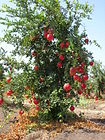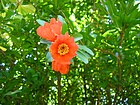Note: This is a project under development. The articles on this wiki are just being initiated and broadly incomplete. You can Help creating new pages.
Difference between revisions of "Punica granatum - Dadima"
(→How to plant/cultivate) |
|||
| (13 intermediate revisions by 2 users not shown) | |||
| Line 1: | Line 1: | ||
[[File:Grenadier (Turpin).JPG|thumb|right|''Dadima'', ''Punica granatum'']] | [[File:Grenadier (Turpin).JPG|thumb|right|''Dadima'', ''Punica granatum'']] | ||
| − | '''Dadima''' | + | '''Dadima''' has been used for thousands of years to cure a wide range of diseases across different cultures and civilizations. It has great nutritional value and numerous health benefits. This plant is belongs to '''Punicacea''' family.<ref name="Plant family"/> |
| − | |||
==Uses== | ==Uses== | ||
{{Uses|Ulcers}}, {{Uses|Urinary infections}}, {{Uses|Skin disorders}}, {{Uses|Digestive disorders}}, {{Uses|Arthritis}}, {{Uses|Diarrhea}}, {{Uses|Bloating}} | {{Uses|Ulcers}}, {{Uses|Urinary infections}}, {{Uses|Skin disorders}}, {{Uses|Digestive disorders}}, {{Uses|Arthritis}}, {{Uses|Diarrhea}}, {{Uses|Bloating}} | ||
| Line 8: | Line 7: | ||
==Parts Used== | ==Parts Used== | ||
{{Parts Used|Fruits}}, {{Parts Used|Seeds}} | {{Parts Used|Fruits}}, {{Parts Used|Seeds}} | ||
| − | |||
==Chemical Composition== | ==Chemical Composition== | ||
| − | Pomegranate fruit arils contain huge amounts of organic acids, sugars, minerals, vitamins, and polyphenols that show antioxidant effect. | + | Pomegranate fruit arils contain huge amounts of organic acids, sugars, minerals, vitamins, and polyphenols that show antioxidant effect.<ref name="Chemical Composition"/> |
| − | <ref name="Chemical Composition"/> | ||
==Common names== | ==Common names== | ||
| − | {{Common names|kn= | + | {{Common names|kn=Daadima, Daalimbe, Dadimbe|ml=Dadimam, Matalam, Matalam-cheti, Matalanarakam, Urumampazham|sa=Dadima, Raktabija, Raktapushpa, Lohithapushpa|ta=Madalai-p-pazham, Maathulai, Maathulam|te=Daadimba, Daalimba chettu, Daalimma, Daanimma, Dadima|hi=Anar|en=Pomegranate}} |
<ref name="Common names"/> | <ref name="Common names"/> | ||
| Line 43: | Line 40: | ||
===Flower=== | ===Flower=== | ||
| − | {{Flower|Bisexual| | + | {{Flower|Bisexual|Axillary or terminal|Scarlet red|Many|Flowers scarlet red or white, conspicuous, 3 cm or more in length. Calyx 20-35 mm long.}} |
===Fruit=== | ===Fruit=== | ||
| − | {{Fruit|A berry|2-8 cm across| | + | {{Fruit|A berry|2-8 cm across|Partitioned by thin leathery yellow septa; the rind thick and coriaceous|Seeds red or pink|}} |
===Other features=== | ===Other features=== | ||
| Line 73: | Line 70: | ||
File:Pomegranate02 edit.jpg | File:Pomegranate02 edit.jpg | ||
File:Granadas - Pomegranates.jpg | File:Granadas - Pomegranates.jpg | ||
| − | |||
| − | |||
| − | |||
| − | |||
</gallery> | </gallery> | ||
==References== | ==References== | ||
| − | |||
<references> | <references> | ||
| − | <ref name="Chemical Composition"> | + | <ref name="Chemical Composition"> Chemical Composition</ref> |
| − | + | <ref name="Uses">[https://www.ncbi.nlm.nih.gov/pubmed/21623786 Uses]</ref> | |
| − | <ref name="Uses">https://www.ncbi.nlm.nih.gov/pubmed/21623786 | + | <ref name="Leaf">FLOWERING PLANTS OF KERALA VER.2, N.SASIDHARAN BOTANIC DESCRIPTION</ref> |
| − | <ref name="Leaf">FLOWERING PLANTS OF KERALA VER.2, N.SASIDHARAN | + | <ref name="Common names">[http://envis.frlht.org/bot_search Vernacular names]</ref> |
| − | <ref name="Common names">[http://envis.frlht.org/bot_search | + | <ref name="Ayurvedic preparations">[https://easyayurveda.com/2011/11/04/pomegranate-fruit-benefits-anti-oxidants-plus-tridosha-balancing-ayurveda-details/ Ayurvedic preparations]</ref> |
| − | <ref name="Ayurvedic preparations">[https://easyayurveda.com/2011/11/04/pomegranate-fruit-benefits-anti-oxidants-plus-tridosha-balancing-ayurveda-details/ | + | <ref name="Cultivation details">[https://pfaf.org/user/plant.aspx?latinname=Punica+granatum Cultivation details]</ref> |
| − | + | <ref name="Plant family">Karnataka Aushadhiya Sasyagalu By Dr.Maagadi R Gurudeva, Page no:195</ref> | |
</references> | </references> | ||
==External Links== | ==External Links== | ||
| − | * https://www.planetayurveda.com/library/pomegranate-punica-granatum | + | * [https://www.planetayurveda.com/library/pomegranate-punica-granatum Punica granatum on planetayurveda.com] |
| − | * https://easyayurveda.com/2011/11/04/pomegranate-fruit-benefits-anti-oxidants-plus-tridosha-balancing-ayurveda-details/ | + | * [https://easyayurveda.com/2011/11/04/pomegranate-fruit-benefits-anti-oxidants-plus-tridosha-balancing-ayurveda-details/ Punica granatum on easyayurveda.com] |
| − | * https://www.ncbi.nlm.nih.gov/pmc/articles/PMC5730995/ | + | * [https://www.ncbi.nlm.nih.gov/pmc/articles/PMC5730995/ Punica granatum on ncbi.nlm.nih.gov] |
[[Category:Herbs]] | [[Category:Herbs]] | ||
[[Category:Lythraceae]] | [[Category:Lythraceae]] | ||
Latest revision as of 11:33, 11 August 2020
Dadima has been used for thousands of years to cure a wide range of diseases across different cultures and civilizations. It has great nutritional value and numerous health benefits. This plant is belongs to Punicacea family.[1]
Contents
- 1 Uses
- 2 Parts Used
- 3 Chemical Composition
- 4 Common names
- 5 Properties
- 6 Habit
- 7 Identification
- 8 List of Ayurvedic medicine in which the herb is used
- 9 Where to get the saplings
- 10 Mode of Propagation
- 11 How to plant/cultivate
- 12 Commonly seen growing in areas
- 13 Photo Gallery
- 14 References
- 15 External Links
Uses
Ulcers, Urinary infections, Skin disorders, Digestive disorders, Arthritis, Diarrhea, Bloating [2]
Parts Used
Chemical Composition
Pomegranate fruit arils contain huge amounts of organic acids, sugars, minerals, vitamins, and polyphenols that show antioxidant effect.[3]
Common names
| Language | Common name |
|---|---|
| Kannada | Daadima, Daalimbe, Dadimbe |
| Hindi | Anar |
| Malayalam | Dadimam, Matalam, Matalam-cheti, Matalanarakam, Urumampazham |
| Tamil | Madalai-p-pazham, Maathulai, Maathulam |
| Telugu | Daadimba, Daalimba chettu, Daalimma, Daanimma, Dadima |
| Marathi | NA |
| Gujarathi | NA |
| Punjabi | NA |
| Kashmiri | NA |
| Sanskrit | Dadima, Raktabija, Raktapushpa, Lohithapushpa |
| English | Pomegranate |
Properties
Reference: Dravya - Substance, Rasa - Taste, Guna - Qualities, Veerya - Potency, Vipaka - Post-digesion effect, Karma - Pharmacological activity, Prabhava - Therepeutics.
Dravya
Rasa
Madhura (Sweet), Amla (Sour), Kashaya (Astringent)
Guna
Laghu (Light), Snigdha (Unctuous)
Veerya
Anushna (Neither hot nor cold)
Vipaka
Madhura (Sweet), Amla (Sour)
Karma
Vata, Pitta, Kapha
Prabhava
Habit
Identification
Leaf
| Kind | Shape | Feature |
|---|---|---|
| Simple | Opposite | Leaves glabrous, lustrous, 19-35(-50) x 8-12 (-15) mm, oblong-lanceolate to obovate or elliptic, subpetiolate, entire, apex sub-actue to obtuse. |
Flower
| Type | Size | Color and composition | Stamen | More information |
|---|---|---|---|---|
| Bisexual | Axillary or terminal | Scarlet red | Many | Flowers scarlet red or white, conspicuous, 3 cm or more in length. Calyx 20-35 mm long. |
Fruit
| Type | Size | Mass | Appearance | Seeds | More information |
|---|---|---|---|---|---|
| A berry | 2-8 cm across | Partitioned by thin leathery yellow septa; the rind thick and coriaceous | Seeds red or pink | {{{6}}} |
Other features
List of Ayurvedic medicine in which the herb is used
Where to get the saplings
Mode of Propagation
How to plant/cultivate
Seed - sow spring in a greenhouse, preferably at a temperature of 22°c, Cuttings of half-ripe wood, 4 - 5cm also propagate well. [7]
Commonly seen growing in areas
Tropical area, Sub Tropical area, Desert area.
Photo Gallery
References
- ↑ Karnataka Aushadhiya Sasyagalu By Dr.Maagadi R Gurudeva, Page no:195
- ↑ Uses
- ↑ Chemical Composition
- ↑ Vernacular names
- ↑ FLOWERING PLANTS OF KERALA VER.2, N.SASIDHARAN BOTANIC DESCRIPTION
- ↑ Ayurvedic preparations
- ↑ Cultivation details
External Links
- Ayurvedic Herbs known to be helpful to treat Ulcers
- Ayurvedic Herbs known to be helpful to treat Urinary infections
- Ayurvedic Herbs known to be helpful to treat Skin disorders
- Ayurvedic Herbs known to be helpful to treat Digestive disorders
- Ayurvedic Herbs known to be helpful to treat Arthritis
- Ayurvedic Herbs known to be helpful to treat Diarrhea
- Ayurvedic Herbs known to be helpful to treat Bloating
- Herbs with Fruits used in medicine
- Herbs with Seeds used in medicine
- Herbs with common name in Kannada
- Herbs with common name in Hindi
- Herbs with common name in Malayalam
- Herbs with common name in Tamil
- Herbs with common name in Telugu
- Herbs with common name in Sanskrit
- Herbs with common name in English
- Habit - Shrub or small tree
- Index of Plants which can be propagated by Seeds
- Index of Plants which can be propagated by Cuttings
- Herbs that are commonly seen in the region of Tropical area
- Herbs that are commonly seen in the region of Sub Tropical area
- Herbs that are commonly seen in the region of Desert area
- Herbs
- Lythraceae




